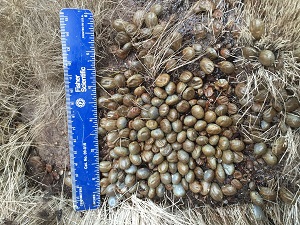
A hunt limited to taking about 33 moose in Vermont’s Wildlife Management Unit (WMU) E in the northeastern corner of the state is proposed in order to reduce the impact of winter ticks on the moose population.
The proposal was presented by the Fish and Wildlife Department to the Vermont Fish and Wildlife Board at its February 19 meeting in Montpelier.
“Moose density in WMU E is more than one moose per square mile, significantly higher than any other part of the state,” said Nick Fortin, Vermont Fish and Wildlife’s biologist in charge of the moose project. “Moose densities greater than one per square mile support high numbers of winter ticks which negatively impact moose health and survival.”
The Fish and Wildlife Department partnered with University of Vermont researchers to conduct a study of moose health and survival in WMU E. The results of this study, in which 126 moose (36 cows, 90 calves) were fitted with GPS tracking collars, clearly showed that chronic high winter tick loads have caused the health of moose in that part of the state to be very poor. Survival of adult moose remained relatively good, but birth rates were very low and less than half of the calves survived their first winter.
“Research has shown that lower moose densities, like in the rest of Vermont, support relatively few winter ticks that do not impact moose populations,” said Fortin. “Reducing moose density decreases the number of available hosts which in turn decreases the number of winter ticks on the landscape.”
The goal of the Fish and Wildlife Department’s 2020 moose season recommendation, that was accepted by the Fish and Wildlife Board at their February 19 meeting, is to improve the health of moose in WMU-E by reducing the impact of winter ticks.
The department would issue 55 either-sex moose hunting permits in WMU-E for the moose seasons this October, which would result in an estimated harvest of 21 bulls, 10 cows and 2 calves.
“This permit recommendation is a conservative first step to addressing winter tick impacts on moose in WMU-E,” added Fortin. “Given the poor health of the moose population in that area and a clearly identified cause, we need to take action to address this issue. Without intervention to reduce the moose population, high tick loads will continue to impact the health of moose in that region for many years.”
The 2020 Moose Season Recommendation and information about the moose study are available on Vermont Fish and Wildlife’s website at www.vtfishandwildlife.com. Comments may be sent to ANR.FWPublicComment@vermont.gov
For Immediate Release: February 20, 2020
Media Contacts: Nick Fortin 802-786-3860; Mark Scott 802-777-4217
